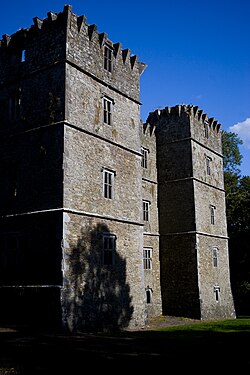Kanturk Castle: Difference between revisions
mNo edit summary |
No edit summary |
||
| (One intermediate revision by the same user not shown) | |||
| Line 8: | Line 8: | ||
|website={{NT link|Kanturk Castle}} | |website={{NT link|Kanturk Castle}} | ||
}} | }} | ||
'''Kanturk Castle''' is a fortified house | '''Kanturk Castle''' is a fortified house at [[Kanturk]] in [[County Cork]], built in 1601 for MacDonagh McCarthy as a defence against English settlers.<ref>[http://www.askaboutireland.ie/learning-zone/primary-students/looking-at-places/cork/moments-in-cork-history/kanturk-castle/ www.askaboutireland.ie ]</ref> It was one of the original properties of the [[National Trust for Places of Historic Interest or Natural Beauty|National Trust]] listed in the private Act of Parliament incorporating the Trust, and it is today owned by ''[[An Taisce]]'', the National Trust for Ireland. | ||
==History== | ==History== | ||
Latest revision as of 13:50, 18 January 2018
| Kanturk Castle | |
|
County Cork | |
|---|---|

| |
| Location | |
| Grid reference: | R38280180 |
| Town: | Kanturk |
| History | |
| Information | |
| Owned by: | An Taisce |
| Website: | Kanturk Castle |
Kanturk Castle is a fortified house at Kanturk in County Cork, built in 1601 for MacDonagh McCarthy as a defence against English settlers.[1] It was one of the original properties of the National Trust listed in the private Act of Parliament incorporating the Trust, and it is today owned by An Taisce, the National Trust for Ireland.
History
The castle was built of limestone rubble, and developed as a grand Tudor mansion four storeys high, 30 yards long and 12 yards wide, with four towers of five storeys high and a height of 95 feet.
According to legend, the castle was never completed as word of its construction reached the Privy Council in England. They ordered MacDonagh to stop building works, as they feared it would be used as a base to attack English settlers. Macdonogh was allegedly so furious at this news that he smashed all the blue ceramic tiles for the roof and threw them into a nearby stream. The stream then became known as the Bluepool Stream because of the reflection of the tiles in the water.